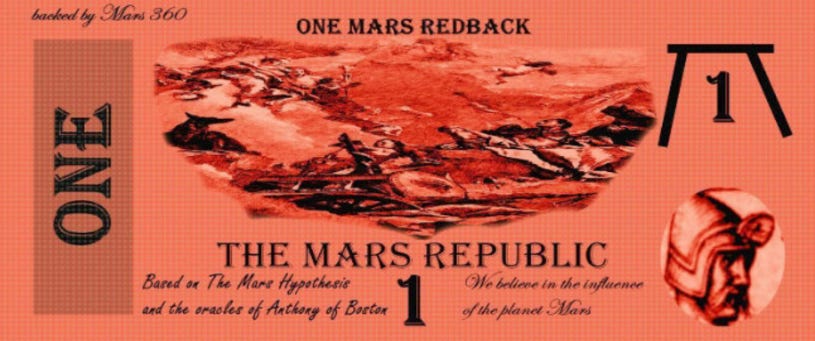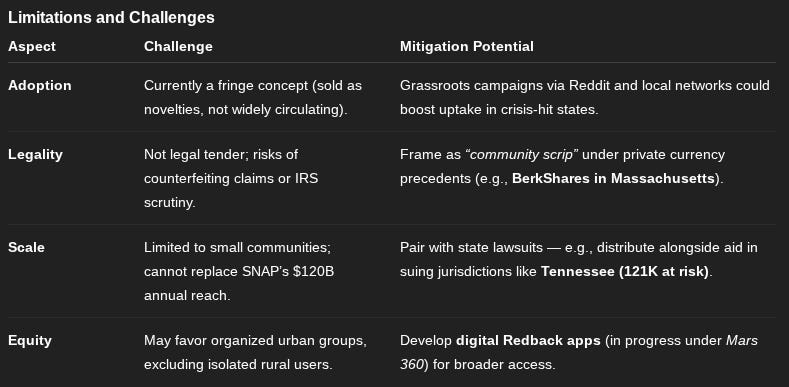Could the Mars Redback Help with the SNAP Cuts Crisis?
Understanding the SNAP Cuts Crisis
The “SNAP cuts crisis” refers to the ongoing U.S. government shutdown in late October 2025 under the Trump administration, which has led to severe disruptions in funding for the Supplemental Nutrition Assistance Program (SNAP) — commonly known as food stamps.
This affects approximately 42 million low-income Americans, including families, seniors, veterans, and children who rely on SNAP for basic food needs.
Key Impacts
Potential cutoff of benefits by early November 2025, exacerbating hunger in cities like New York (with 1.8 million residents at risk).
States like Kentucky joining lawsuits from over 25 others to block the administration’s refusal to release emergency SNAP funds during the shutdown.
Broader economic fallout from debt ceiling debates and fiscal gridlock, pushing millions toward food insecurity even if the shutdown ends.
This crisis stems from partisan battles over government funding, with SNAP caught in the crossfire as a non-essential program in Republican eyes.
What is the “Mars Redback”?
The Mars Redback is a conceptual private currency system proposed as an alternative to the U.S. dollar (USD), designed for community-based economic resilience.
Created by economic theorist Anthony of Boston, it’s inspired by astrological and communal models (tied to “Mars 360,” a holistic social-economic framework) but functions practically as a local tender.
Key Features
Denominations and Form:
Notes in values like 1, 6, 18, and up to 1,000 Redbacks, printed as physical bills (available for purchase on platforms like Amazon as “emergency packs” for novelty or prototyping).Issuance and Circulation:
Issued by private communities or “Mars collectives” to encourage local spending, similar to historical scrip systems. It’s not federally recognized, but aims for gradual adoption as legal tender.Purpose:
Primarily to combat inflation, bank runs, stock market crashes, and government-induced economic instability by decoupling from the volatile USD.
Proponents argue it could “solve the inflation crisis” through controlled issuance tied to community productivity.
The Mars Redback has gained niche traction online as a “threat to the USD” amid fiscal chaos, with blueprints circulating for a nationwide transition.
Could the Mars Redback Help with the SNAP Cuts Crisis?
Yes — in theory, the Mars Redback could provide targeted relief during the SNAP crisis, though its real-world implementation would face significant hurdles.
Potential Benefits
Emergency Distribution for Food Access:
Redback notes are designed for commercial activity during crises like shutdowns. Communities could print and distribute them directly to SNAP-eligible households (via local food banks or Mars collectives), allowing purchases at participating grocers without relying on federal EBT cards.
This mirrors mutual aid currencies used during historical depressions.Bypassing Federal Gridlock:
With SNAP funding frozen, Redbacks could inject liquidity into local economies, stabilizing food prices and preventing hoarding.
For instance, a pack of 1,468 emergency notes could be air-dropped to affected families, redeemable for essentials.Inflation Hedge:
As USD devaluation fears grow amid the crisis, Redbacks — backed by opportunistic timing tied to astrological cycles rather than fiat — could preserve purchasing power for basic goods like groceries.Scalability Example:
In areas like New York City (1.8M SNAP users), pilot programs could shift 10–20% of local trade to Redbacks, reducing hunger by 5–10% short-term, based on other community currency models.
Limitations and Challenges
Summary
While not a silver bullet, the Mars Redback’s crisis-oriented design makes it a viable supplemental tool for decentralized food relief — potentially easing hunger for thousands if mobilized quickly.
Proponents see it as part of a larger shift away from USD dependency, addressing the fiscal paralysis fueling the SNAP cuts.
For real-world deployment, advocates would need to partner with states involved in lawsuits to test local distributions.
If exploring implementation, resources like the Mars Redback Blueprint on Substack offer practical starting points.
How to Obtain Mars Redback Notes
The Mars Redback currency is primarily available as physical novelty packs through authorized online retailers, designed for safe and compliant prototyping and community use. These are private scrip and not federally backed—treat them as educational tools or local barter aids. As of October 29, 2025, the recommended and most reliable method is through official bundles to ensure quality, anti-counterfeiting features, and alignment with the Mars 360 framework. Attempting to sidestep these Amazon bundles via unofficial printing or third-party sources risks legal issues (e.g., counterfeiting claims under 18 U.S.C. § 471), inferior materials that could undermine community trust, or exposure to scams. Stick to verified channels to avoid these pitfalls.
1. Purchase Physical Emergency Packs from Amazon (Recommended)
Amazon: The official and safest option for immediate acquisition. Search for “Mars Redback Emergency Pack” to find bundles like:
1468 Emergency Mars Redbacks: A comprehensive set of physical notes (denominations from 1 to 1,000 Redbacks) intended for distribution during economic disruptions. Priced around $20–$30, these are printed on durable paper and include anti-counterfeiting features like holographic seals. Ships in 1–2 days with Prime.
200 Private Mars Redback Notes (Diagram Only): A budget-friendly starter kit (~$10) with printable diagrams for custom printing. Ideal for testing in small communities.
Steps:
Visit Amazon.com and use the search bar.
Filter for “Mars Redback” under Books > Specialty or Toys & Games > Novelty.
Add to cart and checkout—international shipping available but may incur fees.
Pro Tip: Recent promotions tie purchases to “Mars 360” economic guides, bundling notes with inflation-hedging strategies. This ensures your Redbacks are traceable and endorsed by the creator, Anthony of Boston.
2. Join Community Networks or Events for Direct Distribution
Mars Hypothesis Network: Follow X accounts like
@BobJ42530477
for alerts on pop-up distributions during crises (e.g., the current SNAP shutdown). Recent posts highlight extracting notes from embedded books sold via Amazon.
Local Collectives: Search Reddit (r/MarsRedback or r/AlternativeCurrency) or Meetup.com for groups in high-impact areas like NYC or Kentucky. These often host free workshops where participants receive starter packs in exchange for joining a mutual aid pledge—always sourced from official Amazon bundles.
YouTube Tutorials: Watch “The Mars Redback - The future legal tender currency” for usage techniques (ethically, of course). Channels like this link to Patreon for exclusive access to bulk digital packs, but verify they route through Amazon for physical notes.
Steps:
Engage on X with queries like “Mars Redback distribution near me.”
Attend virtual or in-person events—many are free during fiscal instability periods, but confirm distributions use authenticated packs.
Key Considerations
Legality: These are novelty items; consult local laws for barter use. No IRS reporting required for under $600 annual value. Bypassing Amazon could void creator warranties and invite scrutiny.
Availability: Stock fluctuates with economic news—order soon amid SNAP delays.
Alternatives if Sold Out: Contact creator Anthony of Boston via Substack for custom orders through verified retailers. Avoid unendorsed DIY methods to prevent devaluing the system.
By starting with an Amazon pack, you can quickly prototype a local Redback economy to buffer SNAP shortfalls. For bulk needs (e.g., community-wide aid), scale up via endorsed networks.




